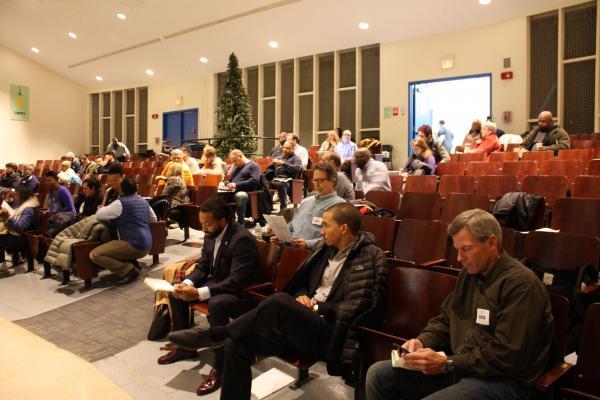December 15, 2016

A scene from a community meeting last Saturday at the Perkins Community Center. Clara Hudson photo
Equity, both racial and transit, was the focus of a community meeting last Saturday at the Perkins Community Center where residents voiced their dissatisfaction with the Fairmount Line commuter rail corridor that runs through neighborhoods with some of the highest concentrations of residents of color in Boston.
The forum, organized by Fairmount/Indigo Network members, attracted about 50 people who wore colorful “My Indigo” stickers that doubled as name tags. The network has long promoted an elusive goal: the rebranding of the Fairmount Line as the Indigo Line and a shift from commuter rail to a rapid transit line like the color-coded “T” subway branches.
Former Gov. Deval Patrick proposed paying $240 million for 30 new Diesel Multiple Unit (DMU) trains, which would allow for an eventual conversion to rapid transit, but that plan was scuttled by Gov. Charlie Baker’s administration, with officials saying that the proposal is now on hold indefinitely.
The state has invested some $200 million for new Fairmount Line stations at Newmarket, Four Corners, and Talbot Avenue, with a four new stops in the final planning stages between Cummins Highway and Blue Hill Avenue in Mattapan. But advocates for a conversion to rapid transit say the new stations are not enough. They want more frequent train service.
“We need a service that goes where we want to go, when we want to go there.” said Mela Bush-Miles, the chair of the Fairmount/Indigo Transit Coalition, which lists some 30 organizations among its members. Equating Rosa Parks and the Montgomery bus boycott of 1955 to current-day transportation segregation and a continuing civil rights movement, Bush-Miles said: “It all started on a bus.”
Buses are still a big part of the Fairmount story, activists say. The corridor spans 9.2 miles from Hyde Park’s Readville neighborhood to South Station. For those who travel to and from downtown, frequent delays affect their everyday commute, limit employment options, and leave them with few choices but to take the bus — particularly when the train schedule proves unreliable.
The meeting was not limited to talk about trains and buses; it was aimed at empowering the attendees to spark solutions, and speakers brought up housing, economic development, and art – such as a design project aimed at amplifying local voices on a poster objecting to the policies of the incoming federal administration. With the antagonism of the recent presidential election in mind, the mood of the session was that now— more than ever— is the time to organize residents of color.
State Rep. Evandro Carvalho of Dorchester, whose district includes a long stretch of the Fairmount line, said he is making the transition proposals his signature project. “We’re here for one thing, and one thing only — that’s to fight,” he said. “The majority of folks who live in these neighborhoods are black people. There’s the Red line, the Orange line, and in the middle there’s us.”
The crowd at times churned with enthusiasm, responding to speakers with, “We can influence change!” and “This is our community!”
Individuals who huddled into smaller groups during the meeting’s breakout session pitched ways to improve the Fairmount/Indigo line: Display the trains’ time of arrival; implement free transfers to bus and subway networks; and bring Charlie Card readers to Dorchester and Mattapan. Some of these ideas are already the norm on the other MBTA subway lines that service more high-volume lines.
At one point, when someone pointed out that inbound signs posted at stations on the Fairmount Line read “To Boston,” many in the group responded, “But we’re already in Boston.”
There were a few at the meeting who worry about a downside to transit improvements – they can foster displacement and gentrification down the road. Harry Smith, from the Dudley Street Neighborhood Initiative, said his priority was making sure that the residents who work hard to uplift their neighborhoods aren’t later pushed out of them.
Community organizer Bob Haas, 72, of Uphams Corner, introduced race into one of the breakout meetings. “In the 1980s, when the first passenger trains ran on this line, one of the issues was racial,” he said. “It’s about segregation, and we are segregated. We don’t have the same kind of service that everyone else has. The thing is, the MBTA won’t spend money on us, and when they do it’s not enough.”
Haas, who is handicapped, described having to pay a $3 penalty for not lining up to buy his ticket before boarding a Fairmount train. He also recounted a time when a friend of his had been charged a penalty for the same reason, despite being legally blind.
Organizers noted that while Haas should not have had to pay a penalty, as those rules had already been altered on the Fairmount line, the T’s conductors, who switch from line to line, are sometimes unaware of the changes.
Joe Pesaturo, a spokesman for the MBTA, said in an email that “in relation to Fairmount, the MBTA would consider the equity impact of pending changes” such as creating the remaining Fairmount line stations.
The Fairmount-Indigo line discussion comes as the MBTA is preparing to completely overhaul its fleet of cars on the Red and Orange line. On Monday, the T’s Fiscal and Management Control Board voted unanimously to replace its entire Red Line fleet by 2024 by purchasing an additional 120 to 134 cars at a cost of up to $280 million.
Topics:


